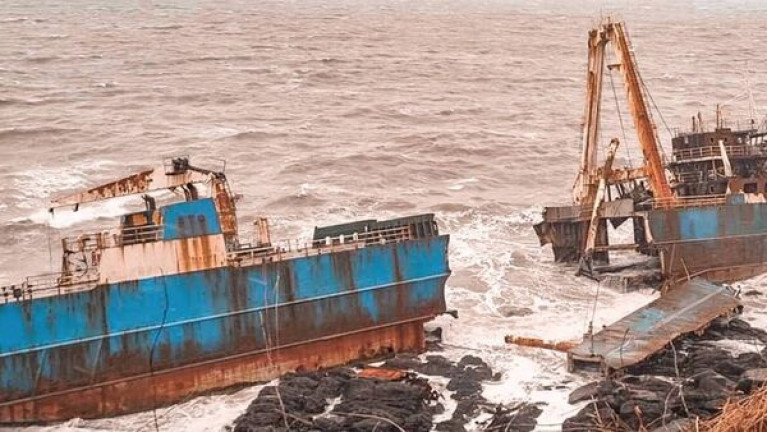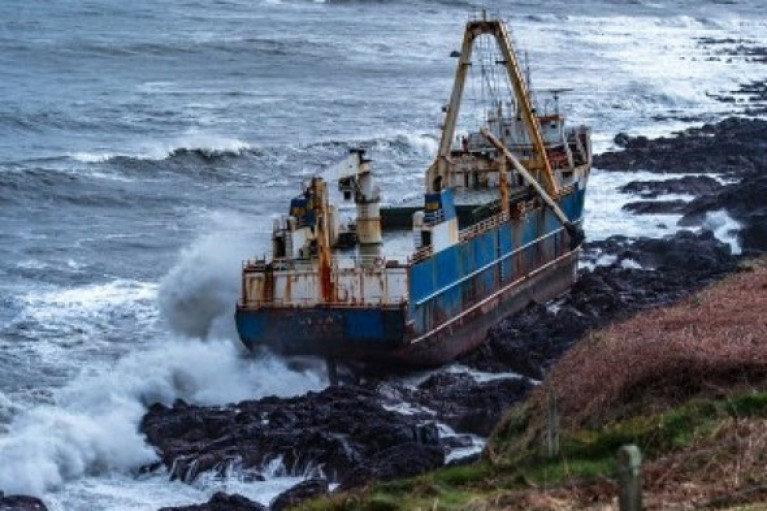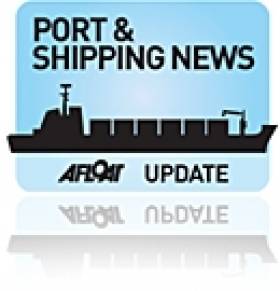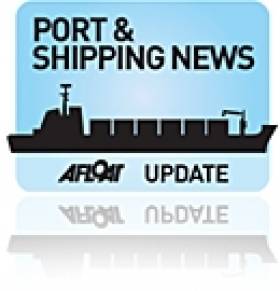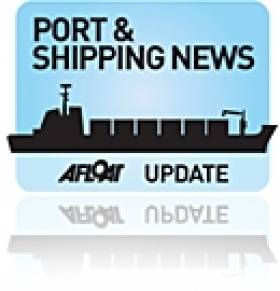Displaying items by tag: Ghost Ship
Cork's 'Ghost Ship' MV Alta May Not Survive the Winter as Photos Show It Breaking Up
The ghost ship MV Alta made famous, after been washed ashore close by of Ballycotton, Co.Cork, during a storm in February 2020, may not last another winter on the rocks, going by the latest images of the shipwreck.
Corkman Charlie Wilkins, a keen amateur photographer, captured the sorry state of the Alta last week when he got some great photos of the wreck in the autumn sunshine.
The photos show the vessel is broken in half, with upperworks looking dangerously unstable and set to break up further, with the likelihood being that large sections of what are left will fall off the rocks and into the deeper water below.
The MV Alta was abandoned at sea by crew in October 2018 after the ship suffered a total engine failure southwest of Bermuda. They were taken off by the US Coast Guard and the ship then began a long, lonely journey, drifting across the Atlantic.
CorkBeo has more on the 1976 built freighter.
Storms Cause Cork's Grounded Ghost-Ship to Split in Two
On the Cork coastline a modern-day "ghost ship" which washed up on rocks in 2020, has split in two after being repeatedly battered during successive storm periods this year.
The MV Alta was grounded in Ballyandreane in Ballycotton, east Cork, on February 16, 2020, during Storm Dennis.
After being abandoned by its 10-man crew during a storm in Bermuda some 16 months earlier, the ship had drifted aimlessly in the Atlantic before winding up in Cork.
From that point on, its condition deteriorated significantly, with fears that it might break apart raised continually since about October 2020.
It now appears as though Storms Dudley, Eunice, and Franklin, which hit the country in quick succession this year, have finally caused the 80m 44-year-old cargo vessel to split.
More from the Irish Examiner on this latest development.
Warning As Irish Coast Guard Say Ghost Ship Could be 'Pilfered' & Urged Council for Security
It has been urged by the Irish Coast Guard that Cork County Council and An Garda Síochána to provide security at the MV Alta shipwreck on the Cork coast last month after it was reported people tried to access the ‘ghost ship’ which drifted ashore at Ballyandreen.
As TheJournal.ie reports, MV Alta was abandoned by its crew in October 2018 after it became disabled en route from Greece to Haiti.
The 44-year-old ship drifted eastwards and was sighted by the Royal Navy in August 2019. The HMS Protector attempted to make contact with the ship but received no response. It continued to drift before landing ashore at Ballyandreen near Ballycotton on 16 February during Storm Dennis.
From the outset, Cork County Council had urged the public to stay away from the potentially dangerous wreck (which last month underwent removal of oil/diesel by the council as Afloat previously reported)
Documents released under Freedom of Information show that three days after the MV Alta ran aground at Ballyandreen, the Irish Coast Guard wrote to The Department of Transport, Tourism and Sport asking it “to impress upon Cork County Council and An Garda Síochána… that they must provide some type of security around the vessel.
More on this story here.
Abandoned Cargo Ship ‘Alta’ Runs Aground On Cork Coast
Ballycotton Sea Adventures is reporting that a cargo ship abandoned at sea for more than a year has run aground on the Cork coastline during Storm Dennis, writes Tom MacSweeney.
An initial Irish Coast Guard inspection of the 'ghost ship' from the air reports no signs of pollution so far from the 80-metre vessel, which lies three miles west of Ballycotton.
The Irish Coast Guard's Twitter account posted video recorded from its Rescue 117 helicopter based in Waterford which was tasked to the location.
Rescue 117 was tasked earlier today to a vessel aground near Ballycotton, Cork. There was nobody on board. Previously the @USCG had rescued the 10 crew members from the vessel back in September 2018. The vessel has been drifting since and today came ashore on the Cork coastline. pic.twitter.com/NbvlZ89KSY
— Irish Coast Guard (@IrishCoastGuard) February 16, 2020
Alta was some 1,500km off West Africa in the autumn of 2018 when its crew abandoned ship, and it remained lost at sea until September last year when it was spotted by the Royal Navy in the middle of the Atlantic.
RTÉ News has more on this breaking story HERE.
During #StormDenis this 80 metre vessel 'The Alta' washed up 3 miles west of #Ballycotton. It was cargo vessel that was abandoned in South East Bermuda in October 2018.
— Ballycotton Sea Adv (@BCSeaAdventures) February 16, 2020
The vessel last spotted off the coast of West Africa in September 2019 and has been wandering seas until today pic.twitter.com/6jUsdpbzy9
'Ghost Yacht' Owner's Hopes Dashed After Naval Service Sinks Vessel For Safety
#GhostYacht - The Naval Service recently sank a 'ghost yacht' off the Irish coast for safety reasons - much to the dismay of its owner.
As The Telegraph reports, German national Thomas Mallanut had travelled to Cornwall after he learned the yacht he'd abandoned off Bermuda almost a year ago, when his wife took seriously ill, was spotted between Ireland and the UK - some 2,700 away.
But yesterday he learned that Irish navy personnel had been ordered to sink the 26-foot yacht as it posed a hazard to shipping.
"He thought he would never see Troll again," said Truro man David Chidell, who had offered to help Mallanut locate his vessel. “It’s just a shame when Tom was told in August that the Irish Navy had spotted it he wasn’t subsequently informed they had decided to sink it.”
The Telegraph has more on the story HERE.
Ghost Ship Haunts Europe - But Still Nowhere To Be Found
#GhostShip - The 'ghost ship' MV Lyubov Orlova is back in the news this week, with renewed fears that she may visit her rat-infested decks upon the shores of Western Europe.
It's almost a year since the erstwhile polar cruise liner broke free from her cabling while being towed from eastern Canada to the Caribbean for scrapping, and her last known whereabouts in late February 2013 put her some 2,400km off the West of Ireland.
By October it was believed the vessel had "vanished from the high seas" though the Irish Coast Guard maintained there was every chance she was still adrift, posing a biohazard for Ireland if she ever reached our shores.
But the recent storms across the North Atlantic have put the Lyubov Orlova back on the agenda, making it more likely than ever that she's been driven closer to our coastline, or those of western Scotland and southwest England - if the extreme conditions haven't sunk the vessel, of course.
Sail World comments on the "star-crossed" history of the ship, which previously ran aground on a voyage in Antarctica, and was finally abandoned by her owners in Newfoundland over a financial dispute.
Much is also being made of the ship's 'cannibal' rats, presumed to have multiplied in great numbers on the derelict liner - and, because they have run out of other food sources, to be eating each other.
But as Irish Coast Guard chief Chris Reynolds tells The Irish Times, "it wouldn’t be at all unusual for there to be lots of rats", especially considering the ship lay empty in Canada for a year before its fateful transport.
Scare stories of rat infestations aside, there is a more clear and present concern: until there's final confirmation of the Lyubov Orlova's whereabouts, she remains a potential hazard to yachts and shipping traffic alike.
“The biggest risk," says Reynolds, "is something hitting it at speed in the dark.” More in The Irish Times HERE.
'Ghost Ship' Still Missing, Believed Vanished In Atlantic
#GhostShip - The saga of the 'ghost ship' MV Lyubov Orlova may finally be at an end, with word that the "rat-ridden" former polar cruise liner has "vanished from the high seas", according to the Irish Independent.
Earlier this year, as reported on Afloat.ie, the Irish Coast Guard was put on alert after indications that the ship - which broke free from its tow line wile being transported from Canada to the Caribbean for scrapping - was adrift in the Atlantic some 2,400km off the West of Ireland.
With no working transponders on the vessel, and no visual confirmation, it was thought weeks later that the Lyubov Orlova may have sunk as it drifted towards Europe.
And later it was suggested that it could be resting at the bottom of the ocean leaking hazardous waste into the delicate deep sea environment - though it's now believed the ship did not carry enough oil to cause a problem.
Even so, there is a chance that the vessel may still be adrift, somehow avoiding detection by passing sea traffic or aircraft, and its cargo of shipborne rats would be considered a biohazard if it reached our shores, according to the Irish Coast Guard chief.
"We don't want rats from foreign ships coming onto Irish soil," said Chris Reynolds. "If it came and broke up on shore, I'm sure local people wouldn't be very happy about it."
The Lyubov Orlova - named after a famous Russian film star - is the sister ship of the polar cruiser Clipper Adventurer, the first cruise liner to visit Drogheda Port.
Abandoned Yacht Surprises Donegal Skipper
#GhostShip - It was an unsettling discovery for a Donegal skipper to happen upon a deserted yacht drifting in the Atlantic Ocean last week.
As BBC News reports, the unmanned vessel materialised in fog off Downings harbour in the north-west of the county, evoking memories of the famous Mary Celeste.
Fearing the worst, local charter boat operator Michael McVeigh sent two divers abroad to investigate, and all they found were rotting food and an e-mail address left on a note on the table.
But the mystery was soon solved after McVeigh contacted Malin Head coastguard - who confirmed that the yacht's owner had been rescued some 600 miles west of Galway.
The yachtsman had been sailing on a "dream trip" from his home in the Azores towards Iceland when he encountered difficulties and used his satellite phone to call for help.
He was later picked up by a passing freighter, leaving his yacht to drift.
BBC News has more on the tale here.
Missing 'Ghost Ship' May Have Sunk In Atlantic
#GhostShip - The Irish Coast Guard is on alert after indications that the missing 'ghost ship' MV Lyubov Orlova may have sunk in the Atlantic as it drifted towards Ireland's coast.
RTÉ News reports that an emergency transponder signal on the vessel that only activates on contact with water was picked up by coastguard monitors last week.
No sign of the ship was detected in satellite images of the area some 1,700km west of Valentia where the signal originated, leading to speculation that the ship has sunk.
But the possibility that the signal device was washed overboard cannot be ruled out.
As previously reported on Afloat.ie, the MV Lyubov Orlova was being transported from Canada to the Caribbean for scrapping in late January when it broke free of its tow-line and went adrift in the Atlantic in the general direction of Europe.
With no lights and its Automatic Identification System (AIS) switched off, it could not be located by conventional means - leading the Irish Coast Guard to collaborate with marine surveillance expert Guy Thomas on his new Global Maritime Awareness system in the hopes of detecting the vessel as it approached Irish waters.
The MV Lyubov Orlova is the sister ship of the polar cruiser Clipper Adventurer, the first ever cruise liner to visit Drogheda Port when it entered the mouth of the Boyne last summer.
Drifting ‘Ghost' Ship’s Sister Made Historic Call to Drogheda
#GhostShip – As previously reported on Afloat.ie, the 'ghost' ship Lyubov Orlova, which broke its tow-line in the Atlantic more than three weeks ago is a sister of the first cruiseship caller to Drogheda Port, writes Jehan Ashmore.
The small cruiseship, Lyubov Orlova of 4,251 tons was built in Croatia a year before Clipper Adventurer, which made a historic call to the port on the Boyne last year. Clipper Adventurer, which was at one stage the Alla Tarasova and Lyubov Orlova belong to a series of eight sisters built for the Murmansk Shipping Company.
As ice-strenghtened vessels, they are designed to withstand heavy seas while operating as expedition ships, carrying passengers to both the Arctic and the Antarctic.
According to Travel.aol.co.uk, the drifting vessel is some 1,200 (nautical miles) off Galway.
A report in Canadian news service The National Post says that the Irish Coast Guard is examining satellite imagery to ensure the ship can be retrieved before it breaks apart or drifts into shipping lanes.
Responsibility for the vessel has already been disavowed by the Canadian authorities after the vessel, which was being towed from Canada to the Dominican Republic for scrapping, broke loose from its cabling.


























